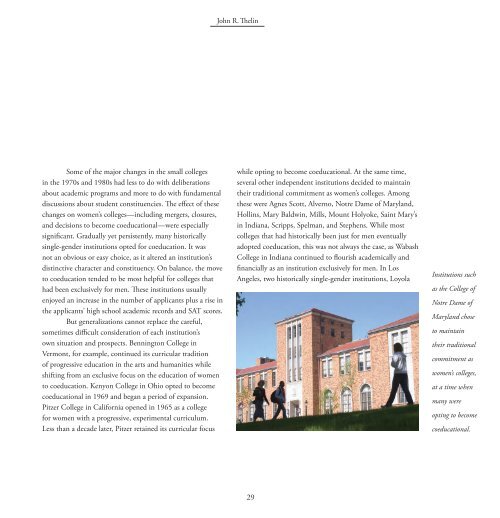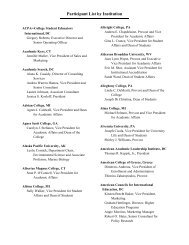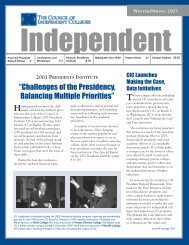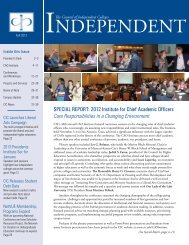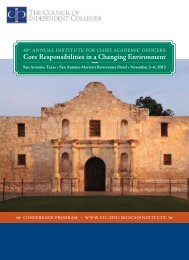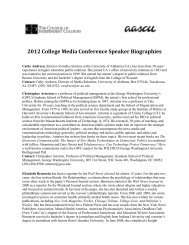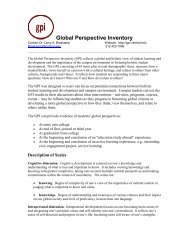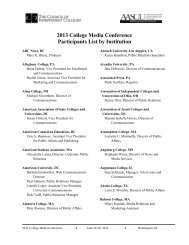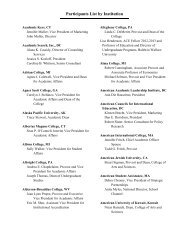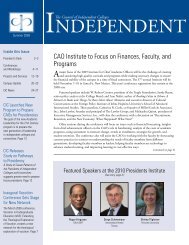Meeting the Challenge: - The Council of Independent Colleges
Meeting the Challenge: - The Council of Independent Colleges
Meeting the Challenge: - The Council of Independent Colleges
You also want an ePaper? Increase the reach of your titles
YUMPU automatically turns print PDFs into web optimized ePapers that Google loves.
John R. <strong>The</strong>lin<br />
Some <strong>of</strong> <strong>the</strong> major changes in <strong>the</strong> small colleges<br />
in <strong>the</strong> 1970s and 1980s had less to do with deliberations<br />
about academic programs and more to do with fundamental<br />
discussions about student constituencies. <strong>The</strong> effect <strong>of</strong> <strong>the</strong>se<br />
changes on women’s colleges—including mergers, closures,<br />
and decisions to become coeducational—were especially<br />
significant. Gradually yet persistently, many historically<br />
single-gender institutions opted for coeducation. It was<br />
not an obvious or easy choice, as it altered an institution’s<br />
distinctive character and constituency. On balance, <strong>the</strong> move<br />
to coeducation tended to be most helpful for colleges that<br />
had been exclusively for men. <strong>The</strong>se institutions usually<br />
enjoyed an increase in <strong>the</strong> number <strong>of</strong> applicants plus a rise in<br />
<strong>the</strong> applicants’ high school academic records and SAT scores.<br />
But generalizations cannot replace <strong>the</strong> careful,<br />
sometimes difficult consideration <strong>of</strong> each institution’s<br />
own situation and prospects. Bennington College in<br />
Vermont, for example, continued its curricular tradition<br />
<strong>of</strong> progressive education in <strong>the</strong> arts and humanities while<br />
shifting from an exclusive focus on <strong>the</strong> education <strong>of</strong> women<br />
to coeducation. Kenyon College in Ohio opted to become<br />
coeducational in 1969 and began a period <strong>of</strong> expansion.<br />
Pitzer College in California opened in 1965 as a college<br />
for women with a progressive, experimental curriculum.<br />
Less than a decade later, Pitzer retained its curricular focus<br />
while opting to become coeducational. At <strong>the</strong> same time,<br />
several o<strong>the</strong>r independent institutions decided to maintain<br />
<strong>the</strong>ir traditional commitment as women’s colleges. Among<br />
<strong>the</strong>se were Agnes Scott, Alverno, Notre Dame <strong>of</strong> Maryland,<br />
Hollins, Mary Baldwin, Mills, Mount Holyoke, Saint Mary’s<br />
in Indiana, Scripps, Spelman, and Stephens. While most<br />
colleges that had historically been just for men eventually<br />
adopted coeducation, this was not always <strong>the</strong> case, as Wabash<br />
College in Indiana continued to flourish academically and<br />
financially as an institution exclusively for men. In Los<br />
Angeles, two historically single-gender institutions, Loyola<br />
Institutions such<br />
as <strong>the</strong> College <strong>of</strong><br />
Notre Dame <strong>of</strong><br />
Maryland chose<br />
to maintain<br />
<strong>the</strong>ir traditional<br />
commitment as<br />
women’s colleges,<br />
at a time when<br />
many were<br />
opting to become<br />
coeducational.<br />
29


